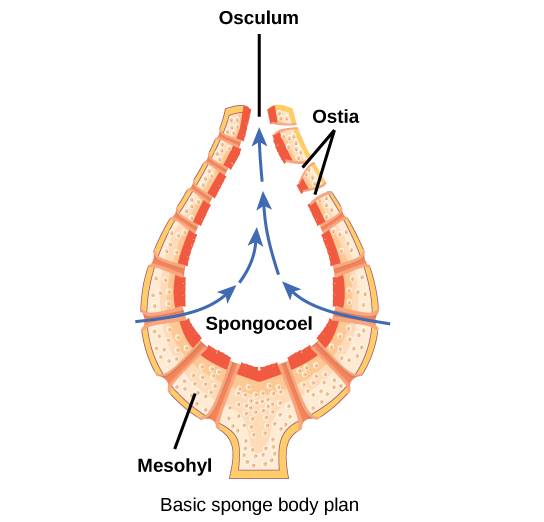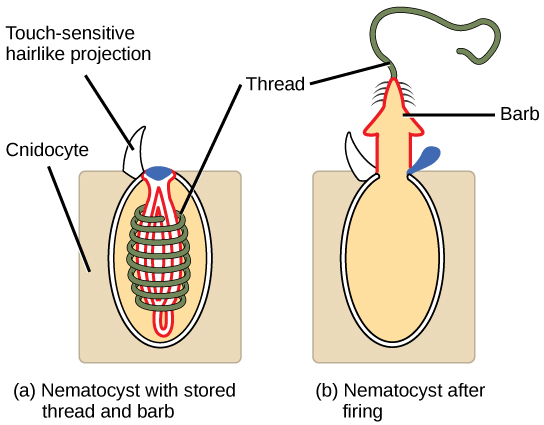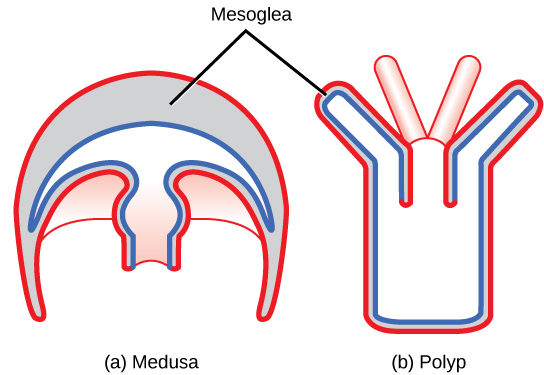| << Chapter < Page | Chapter >> Page > |

Despite their lack of complexity, sponges are clearly successful organisms, having persisted on Earth for more than half a billion years. Lacking a true digestive system, sponges depend on the intracellular digestive processes of their choanocytes for their energy intake. The limit of this type of digestion is that food particles must be smaller than individual cells. Gas exchange, circulation, and excretion occur by diffusion between cells and the water.
Sponges reproduce both sexually and asexually. Asexual reproduction is either by fragmentation (in which a piece of the sponge breaks off and develops into a new individual), or budding (an outgrowth from the parent that eventually detaches). But sponges are also capable of producing gametes, although both types of gametes can be produced in the same individual (hermaphroditism). Sponges may be sequentially hermaphroditic, producing eggs first and sperm later. Eggs areise from amoebocytes and are retained within the spongocoel, whereas sperm arise from choanocytes and a ejected via the osculum. These sperm are carried by the water and fertilize the eggs of other sponges. Larval development starts withing the sponge, and free-swimming larvae are then released via the osculum. This is the only time that sponges exhibit one of the hallmarks of the animal kingdom, motility. The larvae then attach to a substrate and spend their adult lives in the same spot.
The phylum Cnidaria includes animals that show radial symmetry and are diploblastic (have two germ layers instead of the three that most animals have). Nearly all (about 99 percent) cnidarians are marine species, but there are freshwater jellyfish, even in Kansas! Cnidarians have specialized cells known as cnidocytes (“stinging cells”) containing organelles called nematocysts. These cells are concentrated around the mouth and tentacles of the animal and can immobilize prey with toxins. Nematocysts contain coiled threads that may bear barbs. The outer wall of the cell has a hairlike projection that is sensitive to touch. When touched, the cells fire the toxin-containing coiled threads that can penetrate and stun the predator or prey (see [link] ).

Cnidarians display two distinct body plans: polyp or “stalk” and medusa or “bell” ( [link] ). Examples of the polyp form are freshwater species of the genus Hydra ; perhaps the best-known medusoid animals are the jellies (jellyfish). Polyps are sessile as adults, with a single opening to the digestive system (the mouth) facing up with tentacles surrounding it. Medusae are motile, with the mouth and tentacles hanging from the bell-shaped body. In other cnidarians, both a polyp and medusa form exist, and the life cycle alternates between these forms.

All cnidarians have two tissue layers. The outer layer is called the epidermis, whereas the inner layer is called the gastrodermis and lines the digestive cavity. Between these two layers is a non-living, jelly-like mesoglea. There are differentiated cell types in each tissue layer, such as nerve cells, enzyme-secreting cells, and nutrient-absorbing cells, as well as intercellular connections between the cells. However, organs and organ systems are not present in this phylum.
The nervous system is primitive, with nerve cells scattered across the body in a network. The function of the nerve cells is to carry signals from sensory cells and to contractile cells. Groups of cells in the nerve net form nerve cords that may be essential for more rapid transmission. Cnidarians perform extracellular digestion, with digestion completed by intracellular digestive processes. Food is taken into the gastrovascular cavity, enzymes are secreted into the cavity, and the cells lining the cavity absorb the nutrient products of the extracellular digestive process. The gastrovascular cavity has only one opening that serves as both a mouth and an anus (an incomplete digestive system). Like the sponges, Cnidarian cells exchange oxygen, carbon dioxide, and nitrogenous wastes by diffusion between cells in the epidermis and gastrodermis with water.

Notification Switch
Would you like to follow the 'Principles of biology' conversation and receive update notifications?